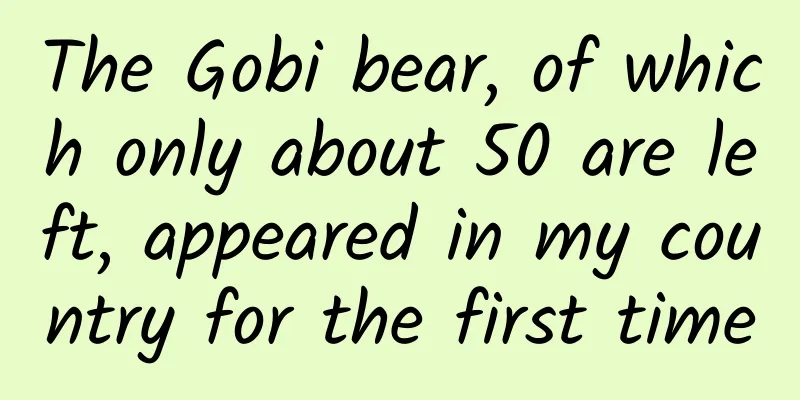The Gobi bear, of which only about 50 are left, appeared in my country for the first time

|
Recently, the Chinese Academy of Forestry discovered Gobi bears in Yiwu County, Xinjiang . This is the first time that Gobi bears have been found in China. Infrared camera photos of Gobi bears taken in Xiamay Township, Yiwu County, Xinjiang | Yiwu County Forestry and Grassland Bureau The Gobi bear (Ursus arctos gobiensis) is the most endangered brown bear in the world and the "national bear" of Mongolia. It is a subspecies of brown bear, with only about 20 individuals left at one time. It was previously only found in the Great Gobi Desert Reserve (GGSPAA) in southwestern Mongolia . They have a monotonous diet and a secretive temperament, and scientists are still working hard to understand them. Brown bears in the Gobi Desert | gobibearproject.org The powerful yet fragile Gobi Desert The Gobi Desert on the border between Mongolia and China is the fifth largest desert in the world. The word "Gobi" also comes from the Mongolian word "Говь", which means desert or gravel desert. The temperature here ranges greatly, reaching minus 40 degrees Celsius in winter and 40 degrees Celsius in summer; the annual precipitation is only 190 mm, which is only equivalent to the 24-hour rainfall of a heavy rainstorm. Common landforms in the Gobi Desert | gobibearproject.org In such a barren environment, scattered oasis complexes support the Gobi Desert ecosystem. These areas often have surface water, which nourishes plants and animals, who come here to find food and drink water. Gobi bears mainly feed on plants in oases, but their single diet makes them particularly vulnerable to environmental damage. If the Gobi Desert becomes drier and fewer plants are available for them to eat, they face the threat of starvation. Since the 1970s, the distribution range of Gobi bears has shrunk by 60% due to factors such as increased competition for water sources and the expansion of human activities . In addition, they are also threatened by poaching and illegal mining. Gobi bears in the bush|gobibearproject.org In order to protect the Gobi bear and other wild animals, Mongolia has established a "strict nature reserve". Since 1985, Mongolia has begun to release food for the Gobi bears in spring and autumn, including wheat, corn, carrots and turnips. Scientists also set up cameras and collected hair at feeding points to understand the population composition of the Gobi bear. In 2009, scientists only found 21 individuals; by 2021, this number finally rose to 51. Despite this, the Gobi bear is still rated as a Critically Endangered (CR) species in the IUCN Red List. Mongolia's "national bear" is both familiar and unfamiliar Despite being Mongolia's "national bear" and in urgent need of protection, the Gobi bear remains quite mysterious to humans . The Gobi Desert is sparsely populated, and Gobi bears are secretive and tend to avoid human grazing and settlements . Scientists have long had difficulty accurately understanding their living conditions. In 1989, the famous wildlife biologist George Schaller went to Mongolia for a field survey. When he was purchasing supplies, he could only find a few cans of peanuts, which was obviously not enough for a scientific expedition team to live in the desert for several weeks. In the end, thanks to the warm hospitality of the local villagers, the scientific expedition was completed. The Gobi Bear commemorative silver coin issued by the Central Bank of Mongolia in 2017 is priced at 300,000 tugriks (about 800 yuan) | news.mn After the 1990s, Mongolia became more open, and Gobi bears and other wildlife resources came into the view of the international scientific community. In order to better protect the Gobi bear and the Gobi Desert ecological environment, the Chinese government officially launched the Gobi bear protection technology project in Mongolia in 2018. This is also the first wildlife protection technology aid project of the Chinese government. Scientists conducted a more in-depth investigation of the local ecological environment to understand the distribution of plants that Gobi bears feed on, and set up more infrared cameras for continuous monitoring. We hope that this project will tell us more about Gobi bears in the next few years. Everything is great and small Gobi bears are now better protected, and surveys over the past decade or so have shown an upward trend in their population; however, their future remains bleak. Gobi bears under the night sky|gobibearproject.org First, the Gobi bear population is still too small. The most optimistic estimate is that there are less than 100 individuals, and the genetic diversity is too low. The extremely low population density of Gobi bears in the vast Gobi Desert also means that individuals may have difficulty finding mates during the estrus period. Moreover, among the 51 known individuals, only 15 are females. Scientists initially suspected that females were more likely to be missed by surveys because of differences in the range and pattern of activities between the sexes; but after combining multiple survey methods for statistics, they ruled out this possibility. Secondly, like many other species, Gobi bears are also affected by climate change. As the environment in the Gobi Desert becomes more hostile, with rising temperatures and less precipitation, Gobi bears will face the threat of food shortages. Climate change will also lead to more frequent local extreme weather events. For such a small population that is only distributed in a specific area, a meteorological disaster is enough to bring about a catastrophe for the entire species. Gobi bears walking in the oasis|gobibearproject.org The Gobi brown bear is a microcosm of many animals affected by the Anthropocene. They have not experienced targeted large-scale hunting, but their living space has been continuously compressed due to climate change and the expansion of human activities. As the only brown bear subspecies living in desert environments, scientists believe that they are likely to carry some unique mutations that allow them to adapt to the harsh environment. I hope they can stay with us and wait for the day when this mystery is revealed. References [1] Tumendemberel O et al. (2021) Ecosphere 12(8):e03696 [2] Tumendemberel O et al. (2015) Ursus 26(2):129-142 [3] IUCN Red List: Brown Bear [4] McCarthy T (2020) Nature 579(7798):338-340 [5] People’s Daily Online: China helps Mongolia protect endangered “national bear” [6] People’s Daily Online: China’s aid to Mongolia’s Gobi bear protection project has achieved phased results Author: Maya Blue Editor: Old Cat This article comes from GuokrNature (ID: GuokrNature) |
>>: Building an ultracold atom quantum simulator: defeating magic with magic!
Recommend
The road to Shu is harder than ascending to heaven: Which road exactly is the road to Shu?
The road to Shu is as difficult as ascending to h...
A woman bought a Mercedes-Benz and drove it for three years before discovering that the wheels were installed backwards and the car was driving backwards every day
After buying a Mercedes-Benz and driving it for t...
"See through!" Chinese scientists take first complete X-ray of the moon
"The bright moon rises over the sea, and peo...
Suifengshuo: The dark side of finance Baidu Cloud download
Suifeng said: Introduction to the black scene res...
Guangzhou Hotel Management Mini Program, How to Make a Hotel Accommodation Mini Program?
With the advent of well-known hotel brands, many ...
Is it okay to dump spent fuel and nuclear waste from nuclear power plants into the crater of an active volcano? What kind of black technology is ADS?
Nuclear power plants will inevitably produce nucl...
Tik Tok’s operation routines to gain millions of fans!
With the end of Produce Camp 2021, Han Mejuan onc...
What to eat for the 2020 college entrance examination? Scientific diet recommendations for the college entrance examination
The college entrance examination is coming soon. ...
Your phone screen is broken? Don’t worry, “live” materials can save it!
Produced by: Science Popularization China Author:...
Entertainment TV shows adapted into movies and games: the superficial prosperity of the IP industry
IP really entered the public eye mainly in 2014. ...
Comprehensive understanding of reinforcement learning from concepts to applications
Although it is the weekend, I still keep rechargi...
How does Baidu bidding hosting need to work?
In the current marketing environment, search engi...
Human-to-human transmission has occurred! Is it from the same family as "smallpox"? How to prevent...
Expert of this article: Zhang Zhidan, chief physi...
Is Wenchang Tower really useful? Correctly understand the role of Wenchang Tower?
The function of Wenchang Tower is to promote chil...
Who is painting the pie and who is sowing the seeds on the eve of China's auto market transformation
The biennial Shanghai International Auto Show is ...









